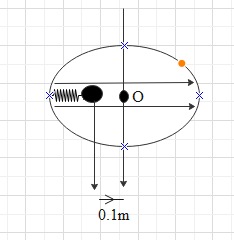
A circular turntable of radius 0.5 m has a smooth groove as shown in figure. A ball of mass 90 g is placed inside the groove along with a spring of spring constant ${{10}^{2}}N/cm$ . The ball is at a distance of 0.1 m from the centre when the turntable is at rest. On rotating the turntable with a constant angular frequency of ${{10}^{2}}{{\sec }^{-1}}$, the ball moves away from the centre by a distance nearly equal to

A. ${{10}^{-1}}m$
B. ${{10}^{-2}}m$
C. ${{10}^{-3}}m$
D. $2\times {{10}^{-1}}m$

Answer
585.9k+ views
Hint: Imagine the figure and try to understand the concept we will use to solve this question. The table will rote and the ball will experience a force towards outside. The ball will move but the spring will oppose this motion and at appoint restoring force of the spring will be equal to the outward centrifugal force on the ball. Equating these two terms, we can obtain the solution.
Complete step by step answer:
The radius of the circular table is $r=0.5m$
A ball with mass $m=90g=0.09kg$ is placed in the groove connecting with a spring with spring constant $k={{10}^{2}}N/cm$
Converting in the SI unit, $k={{10}^{2}}\dfrac{N}{{{10}^{-2}}m}={{10}^{4}}N/m$
The ball is at a distance 0.1 m from the centre of the table when the table is at rest.
Now, let when we rotate the table the ball will feel the centripetal force. It will move towards the side of the table till the centrifugal force is cancelled out by the opposite spring force.
Let the ball move by a distance x. so the distance of the ball from the centre of the table will be, $\left( x+0.1 \right)m$
The table is rotating with an angular velocity, $\omega ={{10}^{2}}{{s}^{-1}}$
Now the centrifugal force on the ball will be,
$\begin{align}
& {{F}_{c}}=m{{\omega }^{2}}\left( x+0.1 \right) \\
& {{F}_{c}}=0.09\times {{10}^{4}}\times (x+0.1) \\
\end{align}$
Restoring force of the spring on the ball will be,
$\begin{align}
& {{F}_{s}}=kx \\
& {{F}_{s}}={{10}^{4}}x \\
\end{align}$
Now equating both forces, we get that,
$\begin{align}
& {{F}_{S}}={{F}_{c}} \\
& {{10}^{4}}x=0.09\times {{10}^{4}}x+90 \\
& 0.99\times {{10}^{4}}x=90 \\
& x=\dfrac{90}{0.99\times {{10}^{4}}}=.9\times {{10}^{-2}} \\
& x\approx {{10}^{-2}}m \\
\end{align}$
The correct option is (B)
Note: if we have the system as if the spring is connected to the centre of the table instead of the side, then also we would have got the same answer. This is because. The amount by which the spring opposes the compression, with the same amount of force it will also oppose the expansion of the spring.
Complete step by step answer:
The radius of the circular table is $r=0.5m$
A ball with mass $m=90g=0.09kg$ is placed in the groove connecting with a spring with spring constant $k={{10}^{2}}N/cm$
Converting in the SI unit, $k={{10}^{2}}\dfrac{N}{{{10}^{-2}}m}={{10}^{4}}N/m$
The ball is at a distance 0.1 m from the centre of the table when the table is at rest.
Now, let when we rotate the table the ball will feel the centripetal force. It will move towards the side of the table till the centrifugal force is cancelled out by the opposite spring force.
Let the ball move by a distance x. so the distance of the ball from the centre of the table will be, $\left( x+0.1 \right)m$
The table is rotating with an angular velocity, $\omega ={{10}^{2}}{{s}^{-1}}$
Now the centrifugal force on the ball will be,
$\begin{align}
& {{F}_{c}}=m{{\omega }^{2}}\left( x+0.1 \right) \\
& {{F}_{c}}=0.09\times {{10}^{4}}\times (x+0.1) \\
\end{align}$
Restoring force of the spring on the ball will be,
$\begin{align}
& {{F}_{s}}=kx \\
& {{F}_{s}}={{10}^{4}}x \\
\end{align}$
Now equating both forces, we get that,
$\begin{align}
& {{F}_{S}}={{F}_{c}} \\
& {{10}^{4}}x=0.09\times {{10}^{4}}x+90 \\
& 0.99\times {{10}^{4}}x=90 \\
& x=\dfrac{90}{0.99\times {{10}^{4}}}=.9\times {{10}^{-2}} \\
& x\approx {{10}^{-2}}m \\
\end{align}$
The correct option is (B)
Note: if we have the system as if the spring is connected to the centre of the table instead of the side, then also we would have got the same answer. This is because. The amount by which the spring opposes the compression, with the same amount of force it will also oppose the expansion of the spring.
Recently Updated Pages
Is work a scalar or a vector quantity class 11 physics CBSE

Aluminium is used in thermite welding because it A class 11 chemistry CBSE

Why is the change in enthalpy zero for isothermal class 11 physics CBSE

Explain Rutherfords alpha ray scattering experiment class 11 chemistry CBSE

There are 720 permutations of the digits 1 2 3 4 5 class 11 maths CBSE

EDTA is a multidentate ligand Its denticity or multiplicity class 11 chemistry CBSE

Trending doubts
What is meant by exothermic and endothermic reactions class 11 chemistry CBSE

10 examples of friction in our daily life

One Metric ton is equal to kg A 10000 B 1000 C 100 class 11 physics CBSE

1 Quintal is equal to a 110 kg b 10 kg c 100kg d 1000 class 11 physics CBSE

Difference Between Prokaryotic Cells and Eukaryotic Cells

What are Quantum numbers Explain the quantum number class 11 chemistry CBSE




